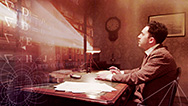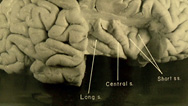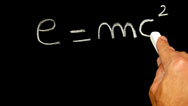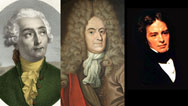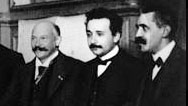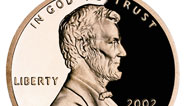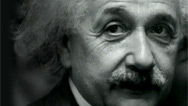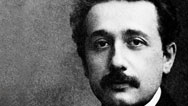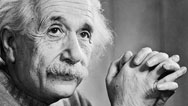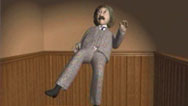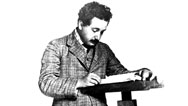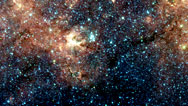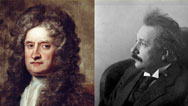
Einstein's Big Idea
The story behind the world's most famous equation, E = mc2 Airing October 11, 2005 at 9 pm on PBS Aired October 11, 2005 on PBS
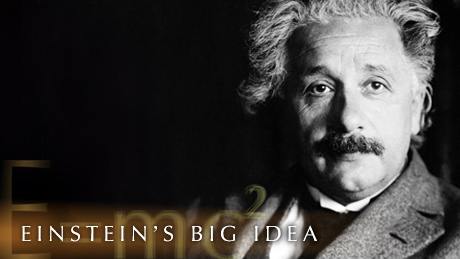
Program Description
Transcript
Einstein's Big Idea
PBS Airdate: October 11, 2005
NARRATOR: When we think of E = mc2 we have this vision of Einstein as an old wrinkly man with white hair. E = mc2 is not about an old Einstein. It's actually about a young, energetic, dynamic, even a sexy Einstein.
ALBERT EINSTEIN: What would I see if I rode on a beam of light?
MICHAEL FARADAY (Dramatization): Perhaps some sort of electrical force is emanating outwards from the wire.
HUMPHRY DAVY (Dramatization): What?
WILLIAM THOMAS BRANDE (Dramatization): Faraday, my dear boy, electricity flows through a wire, not sideways to it.
MICHAEL FARADAY: You see, John? You see?
ANTOINE LAVOISIER (Dramatization): It is my great ambition to demonstrate that nature is a closed system, that in any transformation no amount of matter, no mass, is ever lost, and none is gained.
JEAN-PAUL MARAT (Dramatization): The people...
CAPTAIN: Lavoisier.
JEAN-PAUL MARAT: ...it is they who will determine right and wrong.
FRANCOIS-MARIE AROUET DE VOLTAIRE (Dramatization): Emilie, you are being absurd. Why ascribe to an object a vague and immeasurable force like vis viva? It is a return to the old ways.
EMILIE DU CHíTELET (Dramatization): Are you capable of discovering something of your own?
FRANCOIS-MARIE AROUET DE VOLTAIRE: I discovered you.
EMILIE DU CHíTELET: There is no right time for the truth.
OTTO HAHN (Dramatization): Fraulein Meitner?
LISE MEITNER (Dramatization): Yes?
OTTO HAHN: Otto Hahn.
LISE MEITNER: The nucleus is our focus.
KURT HESS (Dramatization): The Jewess endangers our Institute.
HEINRICH HORLEIN (Dramatization): We can't harbor a Jew. If she stays the regime will shut us all down.
LISE MEITNER: He's split the atom.
OTTO ROBERT FRISCH (Dramatization): No, no, no. You've split the atom.
ALBERT EINSTEIN (Dramatization): Energy equals mass times the square of the speed of light.
MILEVA MARIC EINSTEIN (Dramatization): Would you like me to check your mathematics?
Google is proud to support NOVA in the search for knowledge: Google.
Major funding for NOVA is provided by the Howard Hughes Medical Institute, serving society through biomedical research and science education: HHMI.
Funding for Einstein's Big Idea is provided by the National Science Foundation, America's investment in the future.
And by the Alfred P. Sloan Foundation, to enhance public understanding of science and technology.
And the U.S. Department of Energy, fostering science and security.
Major funding for NOVA is also provided by the Corporation for Public Broadcasting and by PBS viewers like you. Thank you.
NARRATOR: A hundred years ago, a deceptively simple formula revealed a hidden unity, buried deep in the fabric of the universe. It tells of a fantastic connection between energy, matter and light. Its author was a youthful Albert Einstein. It's the most famous equation in the world: E = mc2.
STATION MASTER (Dramatization): All aboard.
NARRATOR: But while we've all heard of Einstein's big idea, very few of us know what it means. In fact, E = mc2 is so remarkable that even Einstein wasn't sure if it was really true.
MILEVA MARIC EINSTEIN: Albert, darling, you are later than I expected. We've only got sausage and cheese tonight. What is it?
ALBERT EINSTEIN: We need to talk.
MILEVA MARIC EINSTEIN: Has something happened?
ALBERT EINSTEIN: Oh, no, nothing, sorry, no. I spent most of the day staring out the window at work looking at trains, and I started to think about an object and how much energy it had. Can I explain it to you?
MILEVA MARIC EINSTEIN: Of course you can, but first, dinner—food and talk.
ALBERT EINSTEIN: I think the gods are laughing at me.
NARRATOR: The gods were not laughing at Einstein. He'd united, in one stunning insight, the work of many who had come before him, scientists who'd fought, and even died, to create each part of the equation. The story of E = mc2 starts long before Einstein, with the discovery of "E" —for energy.
In the early 19th century, scientists didn't think in terms of energy. They thought in terms of individual powers or forces. These were all disconnected, unrelated things: the power of the wind, the force of a door closing, a crack of lightning. The idea that there might be some sort of overarching, unifying energy which lay behind all these forces had yet to be revealed. One lowly man's drive to understand the hidden mysteries of nature would begin to change all that.
DAVID BODANIS (Author, E=mc2): Young Michael Faraday hated his job. He was uneducated; the son of a blacksmith, he'd been lucky to become a bookbinder's apprentice. But Faraday craved one thing, he craved knowledge. He read every book that passed through his hands. He developed a passion for science. All of his free time and his meager wages were poured into his self-education. He was on the threshold of an incredible journey into the invisible world of energy.
NARRATOR: Faraday had impressed one of his master's customers and was rewarded with a ticket that would change his life.
MICHAEL FARADAY: Excuse me please. Can I pass, please?
WILLIAM THOMAS BRANDE: Can I pass?
MICHAEL FARADAY: Some of us are trying to improve ourselves, if people will let us.
CHATER (Dramatization): Of course, of course. Pass, pass. This way to a better life.
S. JAMES GATES, JR. (Physicist, University of Maryland): In the early 1800s, science was the pursuit of gentlemen—something Faraday was clearly not. He had a rudimentary education, he'd read widely, he'd gone to public lectures, but in 1812, he was given tickets to hear Sir Humphry Davy, the most prominent chemist of the age.
NARRATOR: Nineteenth century scientists were the pop stars of their day. Their lectures were hugely popular, tickets were hard to come by, and Davy reveled in his status.
JOHN NEWMAN (Dramatization): They're waiting.
HUMPHRY DAVY: I know.
NARRATOR: He was also a keen follower of the latest fashion: nitrous oxide, or "laughing gas." He said it had all the benefits of alcohol without the hangover.
HUMPHRY DAVY: Electricity, ladies and gentlemen, a mysterious force that can unravel the confusing mixture of intermingled substances that surround us and produce pure, pure elements. How do we do this?
S. JAMES GATES, JR.: Davy was an absolutely first-rate scientist, however, many will come to say that his greatest discovery is Michael Faraday.
HUMPHRY DAVY: ...unknown metals. Unknown that is until I, I isolated potassium from molten potash and sodium, as I showed you last time, from common salt. That same metal...
NARRATOR: Faraday may not have been born a gentleman, but he wasn't going to let class barriers stop him from pursuing a career in science. He worked for nights on end to bind his lecture notes into a book for his new hero.
MICHAEL FARADAY: Lord, help me to think only of others, to be of use to mankind. Help me be part of the Great Circle that is your work and love. Lord, I am your servant.
HUMPHRY DAVY: This is excellent work, Faraday. So, what is it you aim to do with your life?
MICHAEL FARADAY: My desire, sir, is to escape from trade—which I find vicious and selfish—and to become a servant of science, which I imagine makes its pursuers amiable and liberal.
HUMPHRY DAVY: Really? Well, I shall leave it to the experience of a few years to set you right on that score. Look, I haven't anything at the moment. I'll send a note if anything comes up.
NARRATOR: Despite this humiliating setback, Faraday was determined to break free from his daily toil. His patience was rewarded.
HUMPHRY DAVY: Newman, meet Mr. Michael Faraday, he's going to be my helper while I recover. He assures me he is a Christian fellow. Perhaps with God and Faraday in charge of the chemicals you and I will be safe in our place of work.
JOHN NEWMAN: Thank you, Professor Davy. Welcome Faraday.
MICHAEL FARADAY: Oh, no, thank you. And thank you, Sir Humphry.
HUMPHRY DAVY: Just stick to your job and do as you're told, and you'll be fine, Faraday.
NARRATOR: Faraday became the laboratory assistant, eagerly absorbing every scrap of knowledge that Davy deigned to impart. But in time the pupil would surpass the master.
The big excitement of the day was electricity.
HUMPHRY DAVY: Another charge, Newman.
NARRATOR: The battery had just been invented and all manner of experiments were being done. But no one really understood what this strange force of electricity was.
S. JAMES GATES, JR.: The academic establishment, at the time, thought that electricity was like a fluid flowing through a pipe, pushing its way along. But, in 1821, a Danish researcher showed that when you pass an electric current through a wire and place a compass near it, it deflected the needle at right angles.
NARRATOR: This was the first time researchers had seen electricity affect a magnet: the first glimpse of two forces, which had previously been seen as entirely separate, now unified in some inexplicable way.
HUMPHRY DAVY: Faraday, come look at this. You're the bright spark around here, perhaps you can work it out. Oersted's reported an amazing finding. We're just replicating it here.
WILLIAM THOMAS BRANDE: Let's try the compass on the other side.
CHATER: Now, that is remarkable.
WILLIAM THOMAS BRANDE: But if the electrical force is flowing through the wire, why does the needle not move in the same direction, parallel to the wire?
HUMPHRY DAVY: Quite.
CHATER: Let's try turning the whole apparatus round.
HUMPHRY DAVY: Again, Newman.
CHATER: So, the electrical force goes this way, the compass points that way. How can one affect the other?
MICHAEL FARADAY: Perhaps the electricity is throwing out some invisible force as it moves along?
HUMPHRY DAVY: What?
MICHAEL FARADAY: Perhaps some sort of electrical force is emanating outwards from the wire.
WILLIAM THOMAS BRANDE: Oh, my dear boy, let me tell you that at the University of Cambridge, electricity flows through a wire, not sideways to it.
MICHAEL FARADAY: Well, that may be what they teach at Cambridge, but it doesn't explain what's happening before our eyes.
HUMPHRY DAVY: Now, now. Let's just get on. Let's swap the compass to below the wire.
NARRATOR: Why the compass was deflected at right angles, why the electricity was affecting the compass at all, dumbfounded Davy and many others.
MINISTER (Dramatization): As we celebrate the marriage of Michael and Sarah...
NARRATOR: For Faraday, however, the problem became an obsession. It was a fascination inspired by his religion. For him the problem was a way to understand God's hidden mysteries.
DAVID BODANIS: There is a small, almost persecuted group in London called the Sandemanians. They were religious...not really a sect, they were just a small sub-sect, sort of like Quakers. Faraday was a member of that group. It was a very gentle, decent group. They believed that underneath the whole surface of reality, everything was created by God in a unified way—that if you opened up one little part of it you could see how everything was connected.
S. JAMES GATES, JR.: Michael Faraday was someone who, like Einstein, thought in terms of pictures.
DAVID BODANIS: Faraday was different from anybody else. He had a flair for understanding his experiments, for understanding what was really going on inside them.
NARRATOR: By methodically placing a compass all around an electrified wire, Faraday started to notice a pattern.
DAVID BODANIS: What everyone else at the time had been taught was that forces travel in straight lines. Faraday was different. Faraday imagined that invisible lines of force flowed around an electric wire. And then he imagined that a magnet had similar lines emerging from it and that those lines would get caught up in this flow. It was a bit like a flag in a wind.
NARRATOR: But Faraday's great leap of imagination was to turn this experiment on its head. Instead of an electrified wire moving a compass needle, he wondered if he could get a static magnet to move a wire.
JOHN NEWMAN: I've never seen you like this, Faraday. You look like a happy child.
MICHAEL FARADAY: I'm shaking, Newman. Underneath I'm shaking. You see, John, you see?
JOHN NEWMAN: Yes.
S. JAMES GATES, JR.: This is the experiment of the century. It's the invention of the electric motor. Scale up the magnets and the wires; make them really big. Attach heavy weights to them and they'll be dragged along. But almost more importantly, he's inventing a new kind of physics here.
NARRATOR: Although he didn't realize it at the time, Faraday had also just demonstrated an overarching principle. The chemicals in the battery had been transformed into electricity in the wire, which had combined with the magnet to produce motion. Behind all these various forces there was a common energy.
DAVID BODANIS: A couple of months earlier, Davy had been elected President of the Royal Society, which was the elite body of English science. But then he saw this great discovery published in the Quarterly Journal of Science. I don't know if he was envious, but he certainly saw that this young man who had been his assistant, this mere blacksmith's son, had come up with one of the greatest discoveries of the Victorian era.
S. JAMES GATES, JR: Davy accuses Faraday of plagiarizing similar work from another eminent British scientist, William Wollaston.
WILLIAM THOMAS BRANDE: So Faraday, what does Wollaston make of all this?
MICHAEL FARADAY: He's written to me and assures me that he's taken no offense, and he acknowledges that what I published was entirely my own work.
CHATER: Quite, quite. Davy is just being an ass.
MICHAEL FARADAY: But will Davy now retract his allegation?
WILLIAM THOMAS BRANDE: Sadly, no. In fact, he is still vehemently opposed to you being elected a member of the Society.
MICHAEL FARADAY: Really? And what do you think?
WILLIAM THOMAS BRANDE: Faraday, my dear boy, you have my vote.
CHATER: And mine. And I believe you even have Wollaston's.
MICHAEL FARADAY: Oh, what a mess.
WILLIAM THOMAS BRANDE: Well, no matter, no matter. It's the science that counts. So, tell me, how does this wire of yours spin round its magnet? What mysterious forces are at play?
MICHAEL FARADAY: There seems to be an electro-magnetic interaction. In my mind, I see a swirling array of lines of force spinning out of the electrified wire, like a spiraling web.
WILLIAM THOMAS BRANDE: But invisible lines of force? It's all a bit vague, isn't it?
HUMPHRY DAVY: Faraday, might I have a word in private?
MICHAEL FARADAY: Certainly.
HUMPHRY DAVY: Listen, Faraday, let's stop this nonsense. I want you to take down your ballot paper from the notice board.
MICHAEL FARADAY: Sir Humphry, I see no reason to take it down. My friends have proposed me. It is they who put the paper up. I will not take it down. Good day.
NARRATOR: Faraday was elected to the Royal Society. Davy died five years later, a victim of his many gaseous inhalations. In time, Faraday's world of invisible forces would lead to a whole new understanding of energy. He'd started what Einstein would call "The Great Revolution."
It was in the very heart of this exciting new world of energy that Einstein grew up.
ALBERT EINSTEIN: My father and uncle wanted to make their fortune by bringing electric light to the streets of Germany. From an early age I loved to look at machines, understand how things work.
HERMANN EINSTEIN (Dramatization): He's going to kill himself. Albert, stay there.
ALBERT EINSTEIN: I experienced a miracle when my father showed me a compass. I trembled and grew cold. There had to be something behind objects that lay deeply hidden.
At high school, they had their ideas about what I should learn, I had my own. I was merely interested in physics, maths, philosophy and playing the violin. Everything else was a bore.
PROFESSOR FRITZ MUHLBERG (Dramatization): Einstein, on your feet. As you obviously know everything about geology, tell me how do the rock strata run here?
ALBERT EINSTEIN: It's pretty much the same to me whichever way they run, Herr Professor.
NARRATOR: Einstein's teachers tried to drum into him, as Faraday had shown, that energy could be converted from one form into another. They also believed that all forms of energy had already been discovered. Einstein was going to prove them wrong. He would discover a new, vast reservoir of energy, hidden where no other scientist had ever thought of looking, deep in the heart of matter.
A hundred years before Einstein's birth, King Louis the XV was on the throne of France, but the ancient, absolute power of the monarchy over the people was starting to be challenged.
MONSIEUR PAULZE (Dramatization): Jacques, leave the windows, forget the rain, we need air.
NARRATOR: The French Revolution was just around the corner.
PATRICIA FARA (Historian, University of Cambridge): This was the era of the Enlightenment, when intellectuals believed very firmly that the way forward lay in science. And they felt that one of the first tasks that lay ahead of them was to rationalize and to classify every single kind of matter so they could see how it all interacted together.
NARRATOR: Antoine Lavoisier, a wealthy, aristocratic young man decided to take up this task to see if there was some basic connection between all the stuff of everyday life, all the different substances in the world. But what worked for Lavoisier as a scientist—his meticulous, even obsessive attention to detail—was also to be his downfall.
MARIE ANNE PAULZE (Dramatization):Monsieur Lavoisier, you are, if my eyes do not deceive me, consuming only milk this evening. First you had a glass of milk, now you are "eating" a bowl of milk. Will you move on to a plate of milk?
ANTOINE LAVOISIER: Your precise observations commend you as a lady of scientific curiosity, Mademoiselle, most unusual. As you seek knowledge, so I shall dispense it. For the last five weeks I have taken nothing but milk.
COUNT DE AMERVAL (Dramatization): Good god, man, I would rather die than fast on milk for five weeks. Are you in the grip of some horrendous ailment?
ANTOINE LAVOISIER: On the contrary. I am investigating the effects of diet on health.
COUNT DE AMERVAL: Monsieur, with the greatest of respect to a member of the Royal Academy of Sciences, your gut must think your throat has been slit.
MARIE ANNE PAULZE: Whereas your gut, Count, is, no doubt, petitioning the Academy for a widening of your throat.
BARONESS DE LA GARDE (Dramatization): Marie Anne, how dare you insult the Count? Don't forget what the Count offers. Not just marriage, but think of how you will be introduced to all the Salons. You will be the toast of Paris.
ANTOINE LAVOISIER: Would it not be a shame, Madame, to burden you with the duties of matrimony before you have had a chance to experience your curiosity for nature?
BARONESS DE LA GARDE: Shall we all go through? It's getting rather hot in here.
ANTOINE LAVOISIER: Do you really plan to marry de Amerval?
MARIE ANNE PAULZE: There is a plan, but it is not mine.
ANTOINE LAVOISIER: Then I must contrive to save you.
NARRATOR: Lavoisier wasn't a scientist by profession. He was the head of tax enforcement in Paris. His great idea was to build a huge wall around the city and to tax everything that came and went. But his taxes on the simple things in life—bread, wine and cheese—did not endear him to the average Parisian. This scrupulous, fastidious young man did still allow himself the occasional act of passion.
In 1771, Lavoisier married Marie Anne Paulze, the daughter of his colleague in the tax office. Thus he saved her, as he had promised, from an arranged marriage to a count 40 years her elder.
ANTOINE LAVOISIER: Allow me to show you something.
PATRICIA FARA: Lavoisier, I think, found his job as a tax collector really rather tedious, and the times he looked forward to were the evenings and the weekends when he could indulge his passion for chemical experimentation. And he called those times his "jours de bonheur," his "days of happiness."
ANTOINE LAVOISIER: Madame. What will happen if I take a bar of copper or iron and leave it outside in the rain for months on end, Madame Lavoisier?
MARIE ANNE PAULZE: Mmmm, Monsieur Lavoisier?
ANTOINE LAVOISIER: The metals what will become of them?
MARIE ANNE PAULZE: Is this a verbal examination prior to an examination proper, sir?
ANTOINE LAVOISIER: I merely seek the truth.
MARIE ANNE PAULZE: Then you toy with me, Monsieur, for you know the truth. The copper will become covered in a green verdigris and the iron will rust. I believe the term is "calcined."
ANTOINE LAVOISIER: Most impressive, my charming wife. But let me press you further.
MARIE ANNE PAULZE: Mmmm.
ANTOINE LAVOISIER: When the metal rusts, does it get heavier or lighter?
MARIE ANNE PAULZE: Why, sir, I think you mean to trap me.
ANTOINE LAVOISIER: Then perhaps this little butterfly should land and allow me take a closer look.
MARIE ANNE PAULZE: Every last citizen in France of sensible age knows that when a metal rusts it wastes away, it gets lighter and eventually disappears.
ANTOINE LAVOISIER: Ah, but...
MARIE ANNE PAULZE: Huh? Stop. I have not finished. Contain yourself, sir. There is more. In a recently published pamphlet by a brilliant young chemist, Antoine Lavoisier demonstrates that the iron combines with the air. It, in fact, becomes heavier.
ANTOINE LAVOISIER: Most impressive. I intend...
MARIE ANNE PAULZE: Now whatever you intend, Monsieur, I intend to be by your side. I will learn all I can about your science and become your worthy colleague.
ANTOINE LAVOISIER: Then let me show you how the iron combines with the air to form such a delicate union.
MARIE ANNE PAULZE: Tomorrow, Monsieur, tomorrow.
NARRATOR: Marie Anne learned chemistry at her husband's side, but soon sought other ways to contribute to his work. She learned English so that she could translate contemporary scientific works. She took drawing lessons so that she could record in forensic detail the minutiae of their work together. She ran their laboratory and was the public face of "Lavoisier, Inc." She was central to the whole research effort.
MARIE ANNE PAULZE: Monsieur, that is a terrible thing to say. You are a cheeky man.
ANTOINE LAVOISIER: This way please, gentlemen.
Messieurs, it is my great ambition to demonstrate that nature is a closed system, that in any transformation, no amount of matter, no mass, is ever lost, and none is gained. Over here, please.
This precise amount of water is heated to steam. This steam is brought into contact with a red hot iron barrel embedded in the coals. From this end, we cool the steam, but, interestingly, we collect less water than we started with. So clearly we lose a certain amount of water. However, we also collect a gas, and the weight of the iron barrel increases. Now, when we combine these two increases, the new weight of the iron barrel and the gas we have collected, they are exactly equal to the weight of the lost water.
MEMBER OF ACADEMY: Aha! But is it atmospheric air, Monsieur Lavoisier?
ANTOINE LAVOISIER: No, no because I am measuring it, to the very last grain, I can see that it is lighter than the air around us, and moreover, it is flammable. Voila.
DAVID BODANIS: Water is made out of hydrogen and oxygen. So what he had done is get the oxygen to stick to the inside of a red hot iron rifle barrel. He was basically just making rust, which is oxygen iron, but he was making the rust really quickly. Now that left the hydrogen—what he called combustible "air"—and that was just floating around as a gas.
No mass had been lost, it had merely been transformed, and now he wanted to transform it all back into water.
ANTOINE LAVOISIER: This is only the beginning. In the next few months, I hope to demonstrate that I can recombine this combustible air with vital air and transform them both back into water. I will recreate exactly the same amount of water that was lost here in this process. It is my hope to complete the cycle, water into gas into water, and not a drop lost.
DAVID BODANIS: For a long time, Lavoisier had suspected that the exact amount of matter, the mass, involved in any transformation was always conserved. But to prove this he had to perform thousands of experiments, and he had to do the measurements with incredible accuracy. That's where his great wealth from being a tax collector came in. He could afford to commission the most sensitive instruments ever built. He became obsessed with accuracy.
NARRATOR: But Lavoisier's exacting methods were also starting to anger the growing mob of hungry, disenchanted Parisians.
MARIE ANNE PAULZE: Antoine, Antoine. Oh, wake up, Antoine.
ANTOINE LAVOISIER: I'm sorry. What time is it?
MARIE ANNE PAULZE: It is almost time to receive Monsieur Marat. The Academy asked you to assess his designs. He claims to have made a great discovery. Oh Antoine, have you forgotten?
ANTOINE LAVOISIER: What? My god, another charletan with an idea to peddle! God give me patience.
Well, Monsieur Marat.
JEAN-PAUL MARAT: Monsieur, I have invented a device which projects an image of the substance of fire onto a screen. You see, when a lantern is shone through a flame we see a shimmering pattern above the flame. My device renders the substance of fire visible.
ANTOINE LAVOISIER: Have you collected it, this substance of fire? Have you trapped it and measured it?
JEAN-PAUL MARAT: Well, no, but, but one can see it.
ANTOINE LAVOISIER: I'm sorry, in the absence of exact measurements, of precise observations, without rigorous reasoning, one can only be engaging in conjecture. So this is not science.
JEAN-PAUL MARAT: I am not given to conjecture, Monsieur.
ANTOINE LAVOISIER: No. If you will you excuse me, I am extremely busy today. Thank you. Thank you.
JEAN-PAUL MARAT: So that is all? Then, good day, Monsieur.
JEANE MANSON (Dramatization): Let me guess, Marat. The King's scientific despot has decreed that your invention does not conform to the version of the truth as laid down by the Academy.
JEAN-PAUL MARAT: Lavoisier, he talks about facts; he worships the truth.
JEANE MANSON: Listen to me, my friend. They are all the same, the Royal Academies. They insult the liberty of the mind.
JEAN-PAUL MARAT: They think they are the sole arbiters of genius. They are rotten to the core, just like every other tentacle of the King. The people, it is they who will determine right and wrong.
JEANE MANSON: Don't worry. In my next pamphlet, I will expose this persecutor of yours.
NARRATOR: For years the Lavoisier's burned, chopped, melted and boiled every conceivable substance. They'd shown that as long as one is scrupulous about collecting all the vapors, liquids and powders created in a transformation then mass is not decreased. Liquids might become gases, metals may rust, wood may become ash and smoke, but matter, the tiny atoms that make up all substances, none of it is ever lost. The crowning glory of this opus was their remarkable use of static electricity to cause oxygen and hydrogen to recombine back into water.
MARIE ANNE PAULZE: What is happening?
NARRATOR: As the French Revolution exploded, the royal family and whole swathes of aristocrats lost their heads on the guillotine.
PATRICIA FARA: To the French revolutionaries of 1790, Lavoisier meant one thing and one thing only: he was the despised tax collector who'd built the wall around Paris.
NARRATOR: Lavoisier's job as a tax collector brought him under suspicion. He was denounced by a failed scientist turned radical journalist, Jean-Paul Marat.
DAVID BODANIS: What Lavoisier did was absolutely central to science and especially to E = mc2, because what he said is if you take a bunch of matter, you can break it apart, you can recombine it, you can do anything to it, and the stuff of the matter won't go away. If the mob burned Paris to the ground, utterly raised it, shattered the bricks into rubble and dust, and burned the buildings into ashes and smoke, it turns out if you put a huge dome over Paris and weighed all the smoke and all the ashes and all the rubble, it would add up to the exact same weight of the original city and the air around it before. Nothing disappears.
NARRATOR: A century later, all of nature had been classified into two great domains. There was energy—he forces that animated objects—and there was mass—the physical stuff that made up those objects. The whole of 19th century science rested on these two mighty pillars. The laws that governed one did not apply to the other. But young, newly enrolled physics student Albert Einstein didn't like laws.
MICHELE BESSO (Dramatization): Good grief, Einstein, what happened to you?
ALBERT EINSTEIN: It is more than a little ironic, having been reprimanded yesterday by that idiot Professor Pernet for poor attendance, that I should, in fact, attend a practical lesson which was as long as it was boring, and utterly pointless by the way, only to be the victim of an explosion of my own apparatus.
MICHELE BESSO: And so it was your own fault then?
ALBERT EINSTEIN: Thank you. And how are you today, Fraulein Maric?
MILEVA MARIC: Extremely well, Herr Einstein. All the better for seeing you have escaped the physics laboratory with your life.
ALBERT EINSTEIN: Well, in order not to alarm you any further, I pledge to forever continue my studies here at the Cafe Bahnhof, reading only the great masters of theoretical physics and eschewing the babbling nonsense of the polytechnicians.
MICHELE BESSO: Hah. That's about all you ever do.
ALBERT EINSTEIN: It's getting a little stuffy in here, Fraulein Maric. Would you care to take a walk with me? There's something I'd like to discuss with you.
MILEVA MARIC: Why, Herr Einstein, of course. Perhaps, you'd like me to tell you what you have missed in lectures this week?
DAVID KAISER (Physicist and Historian, Massachusetts Institute of Technology): Einstein wasn't exactly a model student. He excelled in certain subjects, especially physics and math, but he wasn't very diligent in a lot of his other classes. He was undoubtedly very questioning, which seems to have annoyed most of his professors throughout his life. He would pursue his fascinations with just incredible determination.
MICHIO KAKU (Physicist, City University of New York): We know from his letters that Einstein, even from the age of 16, was literally obsessed with the nature of light. Everyone he could speak to, his friends, his colleagues, even his then girlfriend, Mileva Maric—who would become his wife—everyone he badgered with the question, "What is light?"
ALBERT EINSTEIN: What would I see if I rode on a beam of light?
MILEVA MARIC: What? A beam of light? By what method do you propose to ride on this beam of light?
ALBERT EINSTEIN: The method is not important. Let us just imagine we two are young, radical, bohemian experimenters, hand in hand, on a journey to the outer reaches of the universe, and we are riding on the front of a wave of light.
MILEVA MARIC: I really don't know what you are suggesting, Herr Einstein. Do you wish to hold my hand or ridicule me?
ALBERT EINSTEIN: Ridicule you? No, never. I merely want you to help me to understand. What would we see, do you think, if we were together, and we sped up and up until we caught up to the front of a beam of light? What would we see?
NARRATOR: It was Einstein's relentless pursuit of light, which would bring about a revolution in science. With light he would reinvent the universe and find a hidden pathway that would unite energy and mass.
Light moves incredibly fast: 670 million miles per hour. That's why scientists use the term "C." It stands for Celeritas, Latin for "swiftness." Long before the 19th century, scientists had computed the speed of light, but no one knew what light actually was. Back in England, a man we've already met was willing to make an educated guess.
After Sir Humphry Davy's death, Michael Faraday became Professor Faraday, one of the most important experimenters in the world. The scientific establishment still found it hard to accept that electricity and magnetism were just two aspects of the same phenomenon, which Faraday called "electromagnetism." But now he has an even more outrageous proposal for his audience.
MICHAEL FARADAY: ...invisible lines that can emanate from electricity in a wire, from a magnet, or even from the sun. For it is my contention that light itself is just one form of these vibrating lines of electromagnetism.
NARRATOR: For 15 years, Faraday struggled to convince the skeptics that Light was an electromagnetic wave, but he lacked the advanced mathematics to back up his idea. Eventually, someone came to his rescue. Professor James Clark Maxwell believed in Faraday's farsighted vision, and he had the mathematical skill to prove it. Maxwell and the aging Faraday became close friends.
MICHAEL FARADAY: James, James, forgive me. A word of advice: don't get old.
JAMES CLARK MAXWELL (Dramatization): Michael, how are you?
MICHAEL FARADAY: Oh, I'm fine. Memory isn't too good though.
JAMES CLARK MAXWELL: Well, I thought you might like to see what I've just published.
MICHAEL FARADAY: Oh, yes, yes, splendid.
JAMES CLARK MAXWELL: So your results show that when electricity flows along a wire what it actually does is create a little bit of magnetism. As that magnetic charge moves it creates a little piece of electricity.
MICHAEL FARADAY: Electricity?
JAMES CLARK MAXWELL: Electricity and magnetism are interwoven, like a never-ending braid, so it is always pulsing forward.
MICHAEL FARADAY: That's wonderful.
JAMES CLARK MAXWELL: Michael, Michael. There's something very crucial in the math. This electricity producing magnetism and magnetism producing electricity, it can only ever happen at a very particular speed. The equations are very clear about it. They come up with just one number, 670 million miles per hour.
MICHAEL FARADAY: I'm not sure I...
JAMES CLARK MAXWELL: It's the speed of light. That is the speed of light. You were right all along, light is an electromagnetic wave.
NARRATOR: Maxwell had proven Faraday right. Electricity and magnetism are just two aspects of a deeper unity, a force, now called electromagnetism, which travels at 670 million miles per hour. In its visible form it is nothing other than light itself.
And nothing fascinated the young Einstein more than light.
MILEVA MARIC EINSTEIN: We have lectures in half an hour.
ALBERT EINSTEIN: Oh, let me think: Professor Weber and his life-draining monologue or you, Mozart and James Clark Maxwell?
MILEVA MARIC EINSTEIN: We can't. We'll get a warning.
ALBERT EINSTEIN: Our project is too precious to waste time listening to those dullards. Come with me. We'll read Maxwell and think about the electromagnetic theory of light.
MILEVA MARIC EINSTEIN: Oh, why, my dear little Johnnie, how you enchant a lady. She's very pretty.
ALBERT EINSTEIN: Yes, but can she soar and dance like our dark souls do?
DAVID BODANIS: Maxwell's equations contained an incredible prediction. They said you could never catch up to a beam of light. Even if you were traveling at 670 million miles an hour, you would still see light squiggle away from you at 670 million miles an hour.
ALBERT EINSTEIN: Do you see how she stares at that wave?
MILEVA MARIC EINSTEIN: Yes.
ALBERT EINSTEIN: You see how, for her, it is static? She and the wave are traveling at the same speed. We see the moving through the water. But relative to her it just sits there. So is light like that?
MILEVA MARIC EINSTEIN: Common sense would say that if you caught up to a light beam, there would be a wave of light, just sitting there. Maybe it would be shimmering, a bit of electricity and a bit of magnetism.
ALBERT EINSTEIN: So, if she was traveling alongside the light wave it wouldn't be moving. It would be static. But Maxwell says you can't have static light.
MILEVA MARIC EINSTEIN: Maybe Maxwell is wrong. Maybe if you catch up to light it is static, Albert, like a wave next to a boat.
ALBERT EINSTEIN: Imagine if I were sitting still and holding a mirror to my face. And the light travels from my face to the mirror, and I see my face. However, if I and the mirror were traveling at the speed of light?
MILEVA MARIC EINSTEIN: You're going at the same speed as the light leaving your face?
ALBERT EINSTEIN: Exactly.
MILEVA MARIC EINSTEIN: The light never reaches the mirror?
ALBERT EINSTEIN: So would I be invisible?
MILEVA MARIC EINSTEIN: That doesn't make sense.
NARRATOR: Young Einstein was starting to realize that light was unlike any other kind of wave.
Einstein was about to enter a surreal universe where energy, mass and the speed of light intermingled in a way no one had ever suspected. But there was one last mathematical ingredient that Einstein would need, the everyday process of squaring.
Long before the French Revolution, scientists were not sure how to quantify motion. Equations that explained how objects moved and collided were in their infancy. A crucial contribution to this subject would come from an unusual source. Meet the aristocratic, 16-year old daughter of one of King Louis the XIV courtiers, Emilie Du Chí¢telet.
CHARLES (Dramatization): Quickly, father's coming.
NARRATOR: Emilie du Chí¢telet would have a huge effect on physics in her tragically short lifetime. Unheard of, for a woman of her time, she would publish many scientific works, including a translation of Sir Isaac Newton's Principia, the greatest treatise on motion ever written. Du Chí¢telet's translation is still the standard text in France today.
TUTOR (Dramatization): Musa, mihi causas memora?
CHARLES: Muse, my memory causes...?
EMILIE DU CHíTELET: "O Muse. The causes and the crimes relate; what goddess was provok'd, and whence her hate; For what offence the Queen of Heav'n began to persecute so brave, so just a man."
EMILIE'S FATHER (Dramatization): Do not be cross with your sister because she persecutes many a just man. Only the other night Emilie silenced the Duc du Luynes when she divided a ridiculously long number in her head in a matter of seconds. You should have seen the incredulity on their faces when they realized Emilie was correct.
CHARLES: Was it my sister's astounding intelligence or her boundless beauty that made their mouths gape, I wonder?
EMILIE'S FATHER: Ah well, yes, you have a point, Monsieur.
EMILIE DU CHíTELET: Messieurs, I thank you for your kindness. I fear, however, that my wit is only a curiosity to others. If only my mind was permitted opportunity.
EMILIE'S FATHER: My dearest, Emilie. You are blessed with intellect and courage. Use them both and the world will fall at your feet.
JUDITH ZINSSER (Du Chí¢telet Biographer): In one sense, she is a woman utterly out of her true time and place. She is a philosopher, a scientist, a mathematician, a linguist. She demands a freedom that women didn't begin to enjoy until over 150 years later, a freedom to study science, to write about it and to be published.
NARRATOR: Du Chí¢telet married a general in the French army at age nineteen and had three children. She ran a busy household, all the while pursuing her passion for science. She was 23 when she discovered advanced mathematics. She enthusiastically took lessons from one of the greatest mathematicians of the day, Pierre de Maupertuis. He was an expert on Newton, and she was his eager young student. It seems they had a brief affair. But then he set off on a Polar Expedition.
Du Chí¢telet then fell passionately in love with Voltaire, France's greatest poet. A fierce critic of the King and the Catholic Church, Voltaire had been in prison twice and exiled to England, where he became enthralled by the ideas of Newton. Back in France, it wasn't long before he again insulted the King. Du Chí¢telet hid him in her country home.
CHARACTER (Dramatization): The poor little creature is devoted to him.
NARRATOR: Isolated far from Paris, Du Chí¢telet and Voltaire turned her chateau into a palace of learning and culture—complete with its own tiny theatre—and all with the apparent blessing of her husband.
PATRICIA FARA: There is a great deal of myth surrounding Du Chí¢telet and her love life. And most of it is very exaggerated. But her husband did accept Voltaire into his household, and he often went to Paris on behalf of Voltaire. He went to his publisher to plead Voltaires' case, to keep Voltaire out of jail. And it is also true that Emilie Du Chí¢telet did have several affairs of a fleeting nature.
JUDITH ZINSSER: She created an institution to rival that of France's Royal Academy of Sciences. Many of the great philosophers, poets and scientists of the day visited.
EMILIE DU CHíTELET: Ah, Monsieur you are young. I hope that soon you will judge me for my own merits or lack of them, but do not look upon me as an appendage to this great general or that renowned scholar. I am, in my own right, a whole person, responsible to myself alone for all that I am, all that I say, all that I do.
NARRATOR: Du Chí¢telet learned from the brilliant men around her, but she quickly developed ideas of her own. Much to the horror of her mentors, she even dared to suspect that there was a flaw in the great Sir Isaac Newton's thinking.
Newton stated that the energy of an object, the force with which it collided with another object, could very simply be accounted for by its mass times its velocity. In correspondence with scientists in Germany, Du Chí¢telet learned of another view, that of Gottfried Leibniz. He proposed that moving objects had a kind of inner spirit. He called it "vis viva," Latin for "living force." Many discounted his ideas, but Leibniz was convinced that the energy of an object was made up of its mass times its velocity, squared.
DAVID BODANIS: Taking the square of something is an ancient procedure. If you say a garden is "four square," you mean that it might be built up by four slabs along one edge and four along the other so the total number of paving slabs is four times four, is 16. If the garden is eight square, eight by eight, well eight squared is 64, it'll have 64 slabs in it. This huge multiplication, this building up by squares is something you'd find in nature all the time.
FRANCOIS-MARIE AROUET DE VOLTAIRE: Emilie, Emilie, you are being absurd. Why ascribe to an object a vague and immeasurable force like vis viva? It is a return to the old ways. It is the occult.
EMILIE DU CHíTELET: When movement commences, you say it is true that a force is produced which did not exist until now. Think of our bodies, to have free will we must be free to initiate motion. So, all Leibniz is asking is, "Where does all this force come from?"
FRANCOIS-MARIE AROUET DE VOLTAIRE: In your case, my dear, the force, I'm sure, is primeval.
EMILIE DU CHíTELET: Aaah, you're infuriating. You hide behind wit and sarcasm. You only think you understand Newton. You are incapable of understanding Leibniz. You are a provocateur. Everything you do is about something else and makes trouble for you. Criticize this, denounce that. Are you capable of discovering something of your own?
FRANCOIS-MARIE AROUET DE VOLTAIRE: I discovered you.
NARRATOR: Despite the overwhelming support for Newton, Du Chí¢telet did not waver in her belief. Eventually, she came across an experiment performed by a Dutch scientist, Willem 'sGravesande that would prove her point.
EMILIE DU CHíTELET: 'sGravesande, in Leiden, has been dropping lead balls into a pan of clay.
FRANCOIS-MARIE AROUET DE VOLTAIRE: Dropping lead balls into clay? How very imaginative.
EMILIE DU CHíTELET: Using Newton's formulas, Monsieur Voltaire, he then drops a second ball from a higher height, calculated to exactly double the speed of the first ball on impact.
So, Messieurs, care for a little wager? Newton tells us that by doubling the speed of the ball, we will double the distance it travels into the clay. Leibniz asks us to square that speed. If he is correct the ball will travel not two, but four times as far. So who is correct?
PIERRE LOUIS DE MAUPERTUIS (Dramatization): Messieurs, I feel Mister Newton's reputation dwindling, ever so slightly.
FRANCOIS-MARIE AROUET DE VOLTAIRE: Oh, Maupertuis, do not succumb to her. There is no earthly reason to ascribe hidden forces to this Dutchman's lead balls.
EMILIE DU CHíTELET: Well, the ball travels four times further.
DAVID BODANIS: Turns out Leibniz is the one who is right. It's the best way to express the energy of a moving object. If you drive a car at twenty miles an hour, it takes a certain distance to stop if you slam on the breaks. If you're going three times as fast, your going sixty miles an hour, it won't take you three times as long to stop, it'll take you nine times as long to stop.
PIERRE LOUIS DE MAUPERTUIS: Oh. Well, it does seem worth consideration.
FRANCESCO ALGAROTTI (Dramatization): Perhaps we might look over his calculations?
EMILIE DU CHíTELET: I have already checked his figures. I am sure Leibniz is correct on this point. I intend to include a section on this matter in my book.
PIERRE LOUIS DE MAUPERTUIS: Really? Do be careful, Madame. Do you think the Academy is ready for such an opinion?
FRANCOIS-MARIE AROUET DE VOLTAIRE: Quite, quite. We really should be careful...
EMILIE DU CHíTELET: "We?"
I see no reason to delay. There is no right time for the truth.
JUDITH ZINSSER: Emilie du Chí¢telet published her Institutions of Physics in 1740, and it provoked great controversy. Voltaire wrote that "she was a great man whose only fault was being a woman." In her day that was a great compliment.
EMILIE DU CHíTELET: I am with child.
FRANCOIS-MARIE AROUET DE VOLTAIRE: You are sure?
EMILIE DU CHíTELET: Undoubtedly. Two to three months. I'm afraid...
FRANCOIS-MARIE AROUET DE VOLTAIRE: You are afraid? Well you should have...Oh, well, this child is obviously not mine, nor is it your husband's. Oh, Emilie, Emilie.
PATRICIA FARA: Emilie Du Chí¢telet knew that in the 18th century, for a woman to become pregnant at the age of forty-three was really very dangerous, and all the while she was pregnant she had terrible premonitions about what was going to happen.
NARRATOR: All her life Du Chí¢telet had tried to rise above the limitations placed on her gender. In the end it was an affair with a young soldier that led to her demise. Six days after giving birth to her fourth child she suffered an embolism and died.
Emilie du Chí¢telet's conviction, that the energy of an object is a function of the square of its speed, sparked a fierce debate. After her death it took a hundred years for the idea to be accepted—just in time for Einstein to use this brilliant insight to finally bring energy and mass together with light.
Einstein pursued light right through university and beyond. Unfortunately, he'd upset so many professors that no one would write him a reference. He accepted a low paying job in the Swiss patent office. He and Mileva married and had a child. The young family struggled, but none of it seems to bother Albert.
DR. HALLER (Dramatization): Einstein, I see you are busy as usual.
Look, Einstein, you have shown some quite good achievements. But listen, about your promotion, I really think it would be better to wait until you have become fully familiar with mechanical engineering. I'm sorry, perhaps next time.
MILEVA MARIC EINSTEIN: But I wanted to hire a maid so I can get back and finish my degree. Now I'll never pass my dissertation.
ALBERT EINSTEIN: Oh, come, come, my pretty little duck. All will be fine, you'll see.
MILEVA MARIC EINSTEIN: But how will it be fine Albert? Do I have to just wait another year, until you are promoted?
ALBERT EINSTEIN: All will be fine. All will be fine. You'll see.
DAVID BODANIS: There really is a very charming, but kind of a self-centered streak to Einstein. He focuses only on his particular obsessions. If the rest of the world fits in around him, that's fine, if they can't, it doesn't bother him.
MICHELE BESSO: Albert, Albert, Albert. A pretty neck and your head spins.
ALBERT EINSTEIN: Besso, we must behold and comprehend the mysterious.
MICHELE BESSO: Well, that kind of mysterious is going to get you into trouble.
ALBERT EINSTEIN: I'll tell you what is truly mysterious, the secret of a long and happy marriage. Ha, ha.
CONRAD HABICHT (Dramatization): The mathematics are fine, if a little unconventional. But this only works for big systems. It'll fall down when you apply it to small systems.
ALBERT EINSTEIN: I disagree.
MICHELE BESSO: Oh, no, here we go: another grand theory by Herr Albert Einstein, Patent Clerk, Third Class.
ALBERT EINSTEIN: What would happen if one applied those formulas to electromagnetic radiation?
CONRAD HABICHT: Albert, you can't just borrow one bit of physics and apply it, without proper regard, to a completely different area.
ALBERT EINSTEIN: Why not?
MICHELE BESSO: Albert, I know you like the grand linkages, the big theories, but wouldn't things be better all'round if you just got going in some small area, got a university post. Get a decent wage, for God's sake. At least Mileva could study again. Then she'd be happy and you'd be happy.
ALBERT EINSTEIN: Ah, the vulgar struggle for survival, food and sex: spoken like a true bourgeois, Besso. I want to know how God created this world. I am not interested in this or that phenomenon, in the spectrum of this or that element. I want to know his thoughts. The rest are details.
MICHELE BESSO: Yes, but you can't feed your children on his thoughts, Bertie.
DAVID KAISER: So it turns out Einstein was going for walk with his very close friend Michele Besso. They'd studied physics together and talked about physics and philosophy for years and years. They were very close. They had cornered the question of light from every possible angle.
NARRATOR: As Einstein and Besso were ruminating on how much time it would take light to reach them from clocks at different distances, Einstein had a monumental insight.
ALBERT EINSTEIN: Thank you, thank you! I've completely solved the problem.
MICHELE BESSO: Albert?
DAVID BODANIS: What Einstein did was completely turn the problem on its head. Other scientists had found it impossible to accept Maxwell's idea that light would always move away from you at 670 million miles an hour, even if you, too, were traveling really fast. But Einstein just accepted that as a fact: light's speed never ever changes. Then what he did was bend everything we know about the universe to fit light's fixed speed. What he discovered was that to do that you have to slow down time.
LISA RANDALL (Physicist, Harvard University): His extraordinary insight is that time...as you approach the speed of light, time itself will slow down. It's a monumental shift in how we see the world.
MICHIO KAKU: The instant, the very instant when Einstein had this brilliant insight that time could slow down, well the floodgates began to open. You see, before then people had assumed that time was like a wristwatch on God's hand, that it beat at a steady rate throughout the universe no matter where you were. Einstein said no, that the tick, tick, tick of this wristwatch was actually the click, click, click of electricity turning into magnetism turning into electricity—in other words, the steady pace of light itself.
DAVID BODANIS: 1905 was a miraculous year for Einstein and for physics. He had an unbelievable outpouring of creativity. It starts with his publication of a paper on how to work out the true size of atoms. Two months later is the publication of his paper on the nature of light. That's what will earn him the Nobel Prize. The third paper, only a month later is on how molecules move when heated, and that finally ends the debate on whether atoms really exist. The fourth paper is published at the end of this half-year period. In it Einstein sets out his theory of light, time and space. It was the "Theory of Special Relativity" that changed the way we see the world.
NARRATOR: In Einstein's new world, the one true constant was not time or even space, but light.
But Einstein's miracle year was not over; in one last great 1905 paper, he would propose an even deeper unity. As he computed all the implications of his new theory he noticed another strange connection, this one between energy, mass and light.
DAVID BODANIS: Einstein realizes that the speed of light is kind of like a cosmic speed limit, nothing can go faster. So imagine we have a train charging along. And let's say it's getting up to the speed of light, and we're stuffing more and more energy in trying to get it to go faster and faster, but it's still bumping up against the speed of light. So all this energy, where does it go? It has to go somewhere. Amazingly it goes into the object's mass. From our point of view, the train actually gets heavier. The energy becomes mass. It's an incredible idea. Even Einstein is amazed by it.
ALBERT EINSTEIN: Look. I think I have found a connection between energy and mass. If I am right then energy and mass are not absolute. They are not distinct. They can be converted into one another. Energy can become mass, and mass can become energy, and not just energy equaling mass. Energy equals mass times the square of the speed of light.
MILEVA MARIC EINSTEIN: Would you like me to check your mathematics?
NARRATOR: Einstein sent his fifth great 1905 paper for publication. In three pages he simply stated that energy and mass were connected by the square of the speed of light: E=mc2. With four familiar notes in the scale of nature, this patent officer had composed a totally fresh melody, the culmination of his 10 year journey into light.
DAVID BODANIS: Here we are, for thousands of years, thinking that over here is a world of objects, of matter, and over there is an entirely separate world of movement, of forces, of energy. And Einstein says "No. They are not separate. Energy can become mass. And crucially, mass can also become energy." There is a deep unity between energy, matter and light.
MICHIO KAKU: "E = mc2." That equation shows that every piece of matter in our universe has stored within it a fantastic amount of energy. The speed of light for example is about 300 million meters per second, you multiply that by itself and you get 90 quadrillion. So, in other words, what is matter? In some sense, matter is nothing but the condensation of vast amounts of energy. So, in other words, if you could unlock, somehow unlock, all the energy stored within my pen, that would erupt with a force comparable to an atomic bomb.
LISA RANDALL: After Einstein's fifth great 1905 paper, physicists no longer spoke of mass or energy. They are now the same thing to us.
NARRATOR: Probably the most miraculous year in human science ends in silence. The articles are published to resounding...nothing.
ALBERT EINSTEIN: I think the Gods are laughing at me.
NARRATOR: Then slowly it starts: a letter here, a letter there. For four years Einstein answered each inquiry dutifully, trying to explain his difficult, complex ideas to a confused physics community.
S. JAMES GATES, JR.: I love the idea that life just went on as normal. Here are these universe-changing papers circling around, and the world is struggling to come to terms with them.
MICHIO KAKU: Einstein had a fan club of just one. Luckily, it happened to be the most important living physicist.
DR. HALLER: Einstein, Einstein. Max Planck has sent someone to see you.
ALBERT EINSTEIN: Max Planck?
DR. HALLER: Yes, he has sent his assistant. He's here to see you.
NARRATOR: Max Planck encourages the world's most eminent physicists to take Einstein seriously. After four years of waiting he is appointed Professor of Physics at Zurich University. From there his career is meteoric. He is made Professor of Physics in Berlin, achieves world renown and becomes a household name. He is the undisputed father of modern physics.
But Einstein's success was the downfall of his marriage. In 1919, he divorced Mileva and married his cousin. His fame led to numerous affairs.
E = mc2 became the Holy Grail of science. It held out the promise of vast reserves of energy locked deep inside the atom. Einstein suspected that it would take a hundred years of research to unlock it. But he hadn't banked on the Second World War and the genius of a Jewish woman in Hitler's Germany.
Twenty-eight year old Austrian Lise Meitner was painfully shy. Despite her anxiety, the young Doctor of Physics arrived in Berlin determined to pursue a career in the exciting, new field of radioactivity. Unfortunately, in 1907, German universities did not employ female graduates. Luckily, one man came to her aid.
OTTO HAHN: Fraulein Meitner?
LISE MEITNER: Yes?
OTTO HAHN: Otto Hahn. I'm a researcher in the Chemistry Institute. Professor Planck suggested I...
LISE MEITNER: Ah yes, Herr Hahn. I have read both your papers on Thorium and Mesothorium. Dr. Planck suggested that I...
OTTO HAHN: Yes, he suggested I speak to you. I need someone to collaborate with.
LISE MEITNER: I think I could really help with the physical analysis.
OTTO HAHN: And the mathematics?
LISE MEITNER: Yes, yes, and the mathematics.
OTTO HAHN: Studying radioactive atoms has become so much a collaboration between chemistry and physics these days.
LISE MEITNER: Yes, yes.
OTTO HAHN: I'll ask Fischer for a laboratory then.
LISE MEITNER: Excellent.
OTTO HAHN: I'll speak to you soon.
NARRATOR: Lise Meitner had just taken the first step on a journey that would irrevocably change world history. For her, it would be a road marked with success and renown, but also with terror and betrayal.
DAVID BODANIS: At this time, not a lot was known about the atom. At first people thought it was like a miniature cellular system, there's a solid nucleus of the center and electrons would spin around it, sort of like planets around our sun. A little later, some researchers proposed that the nucleus itself wasn't a solid chunk but was made up of separate particles, of protons and neutrons. But then, in what are called radioactive metals, things like radium and uranium, the nucleus itself seemed to be unstable, leaking out energy and particles. Perhaps this was an example of E = mc2, the mass of a nucleus turning into energy?
NARRATOR: Meitner and Hahn's collaboration to unlock the secrets of the atom, started out on an extremely unequal footing. He was given a laboratory. She was forced to work in a woodshop.
OTTO HAHN: I see you haven't set your hair on fire?
LISE MEITNER: Herr Hahn?
OTTO HAHN: The boss. He thinks that if he lets women into the Chemistry Institute they'll set their hair on fire.
LISE MEITNER: Ah, so his beard must be fireproof.
STAFF MEMBER (Dramatization): Good day, Herr Hahn.
OTTO HAHN: Good day.
LISE MEITNER: You see. I am nonexistent to this place. At least physicists recognize me for my abilities.
OTTO HAHN: Ah, yes, where would we chemists be without the steadying hand of the physicist?
RUTH LEWIN SIME (Meitner Biographer): It took years, but Lise lost her shyness eventually. In 1912, she and Hahn moved to the brand new Kaiser Wilhelm Institute for Chemistry where their status was really that of equals. Lise became the first woman in Germany to have the title of Professor.
OTTO HAHN: Lise, I have news. You remember the art student I told you of?
LISE MEITNER: Yes. Edith.
OTTO HAHN: Yes, well, I have asked her to marry me, and she has accepted.
LISE MEITNER: Ah. Doctor Hahn, congratulations.
OTTO HAHN: Yes, well, I wanted you to be the first to know.
LISE MEITNER: I'm very pleased for you, very pleased.
RUTH LEWIN SIME: Lise Meitner was warm hearted by nature, she had many friends, and she may have wanted to have a closer relationship with Otto. But it really does seem that physics was Lise's first love, maybe even her passion.
NARRATOR: The 1920s and '30s were the golden age of nuclear research. The largest known nucleus at the time was that of the Uranium atom containing 238 protons and neutrons. Meitner and Hahn were leading the race to see if even bigger nuclei could be created by adding more neutrons.
LISE MEITNER: So, the atom—pretty familiar, nucleus in the center, electrons orbiting around. The nucleus is our focus: the nucleus, made up of protons and neutrons. Now, the largest nucleus we know is that of the Uranium atom. Its nucleus is a tightly packed structure of 238 protons and neutrons. The thrust of our work is to try to fire neutrons into this huge structure, and if we can get a neutron to stick in here, it will be a breakthrough.
NARRATOR: Meitner may have been on the brink of a major discovery, but Germany in the 1930s was a dangerous place to be, even for a world-class scientist.
KURT HESS: The Jewess endangers our Institute.
RUTH LEWIN SIME: When the Nazis came to power, one of the first things they did was to drive out Jewish academics from the universities. Einstein was very prominent, and for that reason he was one of the first to go. He was hounded out of Germany in 1933. Lise was not dismissed at that time. She was able to stay because she was Austrian. But in March 1938, Austria was annexed into Germany, and at that point her situation became untenable.
OTTO HAHN: What is it?
LISE MEITNER: Frightening news.
FRITZ STRASSMAN (Dramatization): What's happened?
LISE MEITNER: Kurt Hess is going around saying that I should be got rid of.
OTTO HAHN: I, I actually knew. I heard today. I was going to speak to the treasurer of the Institute before I told you. We'll speak to him tomorrow.
Come on, let's get you home. It's late. We'll finish up.
NARRATOR: The pressure on Meitner was unbearable. Hahn, who was known for his anti-Nazi views, did his best to protect her, at least initially.
OTTO HAHN: I need to talk to you about Lise.
HEINRICH HORLEIN (Dramatization): Not now, I'm too busy.
OTTO HAHN: We have to protect her.
HEINRICH HORLEIN: How? What can we do? The situation is the way it is. Who knows what could happen next? She can't stay. It's just not tenable.
OTTO HAHN: But she hasn't got a visa or even a valid passport, and she may soon be forbidden to leave Germany.
HEINRICH HORLEIN: We can't harbor a Jew. If she stays the regime will shut us all down.
OTTO HAHN: Lise, Horlein demands that you leave.
FRITZ STRASSMAN: You can't throw her out.
OTTO HAHN: Horlein says you should not come into the Institute any more.
LISE MEITNER: Well, I have to write up the thorium irradiation tomorrow, so I have to come in.
FRITZ STRASSMAN: You've given up.
NARRATOR: When it became clear that Meitner would be dismissed and probably arrested, physicists all around Europe wrote letters inviting her to conferences, giving her an excuse to leave Germany. The Nazis refused to let her go. In July of 1938, a Dutch colleague traveled to Berlin and illegally took Lise back with him on a train to Holland. The trip was so frightening that at one point she begged to go back. Despite the great danger, she got through.
RUTH LEWIN SIME: She had lost everything: her home, her position, her books, her salary, her pension, even her native language. She had been cut off from her work just at the time when she was leading the field and was on the brink of a major scientific discovery.
NARRATOR: No matter what privations she suffered, Lise was still thinking of physics. Amazingly she and Hahn were able to collaborate by letter.
LISE MEITNER: I hope, my dear Otto, that after 30 years of work together and friendship in the institute, that at least the possibility remains that you tell me as much as you can about what is happening back there.
RUTH LEWIN SIME: Lise was invited by an old student friend to spend Christmas on the west coast of Sweden. Her nephew, Otto Robert Frisch, who was also a physicist, came to join her there.
OTTO ROBERT FRISCH: Aunt? Aunt? Aunt Lise? How are you, my dear? Merry Christmas?
Aunt?
LISE MEITNER: I need your help, come on let's go out.
OTTO ROBERT FRISCH: But, I was hoping you'd help me.
NARRATOR: Back in Berlin, Hahn was getting strange results. He found no evidence to suggest that bombarding the uranium nucleus with neutrons had caused it to increase in size. In fact, his experiments seemed to be contaminated with radium, a smaller atom. He desperately needed Meitner's expert analysis. From afar, she was starting to suspect that something very different was happening in their experiment.
LISE MEITNER: Hahn and Strassman are getting some strange results with the uranium work.
OTTO ROBERT FRISCH: Really?
LISE MEITNER: A couple of months ago Hahn told me that they were finding radium amongst the uranium products. We are looking for a much bigger element, and here we are finding something much smaller. I urged Hahn to check again, it couldn't be radium. And now he writes to me and tells me that it's not radium, it's barium.
OTTO ROBERT FRISCH: But that's even smaller.
LISE MEITNER: Exactly. Hahn is sure that it's another error, but I don't know any more. It is at least possible that barium is being produced.
OTTO ROBERT FRISCH: So Hahn still needs you to interpret the data.
LISE MEITNER: It is my work too, you know.
OTTO ROBERT FRISCH: Exactly.
LISE MEITNER: Well, I can't be there, can I? Come on, let's walk.
OTTO ROBERT FRISCH: Surely, he's made a mistake, hasn't he? He hasn't done what you told him to.
LISE MEITNER: My darling, Robert, he may not be a brilliant theorist, but he's too good a chemist to get this wrong.
RUTH LEWIN SIME: If you imagine a drop of water, a big drop, it's unstable, on the verge of breaking apart. It turns out that a big nucleus like uranium is just like that. Now for four years Meitner and Hahn and all other physicists had thought that if you pump more neutrons into this nucleus, it'll just get bigger and heavier. But suddenly Meitner and Frisch, out in the midday snow, realized that this nucleus might just get so big that it would split in two.
LISE MEITNER: If the nucleus is so big that it has trouble staying together, then couldn't just a little tiny jog from a neutron and...
OTTO ROBERT FRISCH: Yes, but if the nucleus did split, the two halves would fly apart with a huge amount of energy. Where's that energy going to come from?
LISE MEITNER: How much energy?
OTTO ROBERT FRISCH: Well, we worked out that the mutual repulsion between two nuclei would generate about 200 million electron volts. But something has to supply that energy.
LISE MEITNER: Wait, let me do a packing fraction calculation. The two nuclei are lighter than the original uranium nucleus by about one-fifth of a proton in mass.
OTTO ROBERT FRISCH: What? So some mass has been lost? Einstein's E = mc2?
LISE MEITNER: If we multiply the lost mass by the speed of light squared we get...200 million electron volts. He's split the atom.
OTTO ROBERT FRISCH: No, no, no. You've split the atom.
RUTH LEWIN SIME: It was an amazing discovery. Of course in the laboratory we are talking about tiny amounts of uranium and correspondingly tiny amounts of energy. But the point is that the amount of energy released was relatively large and that came from the mass of the uranium itself. The energy released was entirely consistent with Einstein's equation, E=mc2.
NARRATOR: Meitner and Frisch published the discovery of what they called nuclear fission to great acclaim. But betrayal awaited them. Otto Hahn was under pressure from the Nazi regime to write his Jewish colleague out of the story. He alone was awarded the 1944 Nobel Prize for the discovery. In his speech he barely mentioned the leading role of Meitner. Bizarrely even after the war, Hahn maintained it was he and not Meitner who had discovered nuclear fission.
LISE MEITNER: Now I want to write something personal, which disturbs me and which I ask you to read with more than 40-year friendship in mind, and with the desire to understand me. I am [now] referred to as "Hahn's long time co-worker." How would you feel if you were only characterized as the longtime co-worker of me? After the last 15 years, which I wouldn't wish on any good friend, shall my scientific past also be taken from me? Is that fair? And why is it happening?
DAVID BODANIS: Lise Meitner had been working on this for 30 years. She'd only broken apart a handful of atoms, but that was enough, once she had broken even one, the genie was out of the bottle.
What Meitner had started...after that physicists around the world began to realize they could take it a lot further.
NARRATOR: In 1942, an intense effort to build an atom bomb was begun. All over America, secret installations sprang up under the code name "The Manhattan Project."
DAVID BODANIS: Meitner was asked to join the Manhattan project, and she refused. She refused to have anything to do with the atomic bomb. But Robert Frisch was different. He was an important member of the team, because he was convinced of the need to beat the Nazis in a nuclear arms race.
NARRATOR: A nuclear bomb was never used on Germany, but the atomic bombs dropped on Hiroshima and Nagasaki demonstrated the terrible destructive power of E = mc2. Vast amounts of energy, in the form of electromagnetic radiation, were released from a few pounds of uranium and plutonium.
While the pure inquisitiveness of the world's most gifted scientists ironically had brought humanity a weapon of mass destruction, the equation's life has a parallel story of creation and beauty. Today, young physicists carry on Einstein's quest. Ever since its birth, E = mc2 has been used to delve into the depths of time, to answer the biggest question of all, "Where did we come from?"
At particle accelerators, researchers propel atomic particles to the speed of light and smash them together, creating conditions like those in the Big Bang.
DAVID KAISER: E = mc2 actually tells us how the Big Bang itself happened. In the first moments of creation, the universe was this immensely dense, immensely concentrated eruption of energy. As it rushed apart and expanded, huge amounts of energy or "E" were converted into mass or "M." Pure energy became matter, it became the particles and atoms, and it eventually formed the first stars.
DAVID BODANIS: Our sun is a huge furnace, floating in space, and it's powered by E = mc2. Now it turns out, every second, four million tons of solid mass of the sun, disappears. It comes out as energy. Not just a little bit of energy, it's enough to light up our entire solar system, make the solar system glow with heat and light.
MICHIO KAKU: And not only do stars emit energy, in accordance with E = mc2, the whole process actually creates life itself. Eventually, a massive star dies, the debris floats around, clusters together, gets pulled into the orbits of another star and becomes a planet. We humans and the earth we stand on are made of stardust; we are a direct product of E = mc2.
NARRATOR: Building on the work of scientists through the ages, new generations are searching for answers. Using bold new tools that reach almost to the speed of light, they can now ask questions that their predecessors could never have even imagined.
As Einstein himself knew, the journey of discovery is sometimes painful, sometimes joyful. It is as old as human curiosity itself and never, ever ends.
Broadcast Credits
Einstein's Big Idea
- Narrated by
- John Lithgow
Based on the book
E=mc2 : A Biography of the World's Most Famous Equation
by David Bodanis
- Written, Produced and Directed by
- Gary Johnstone
- Director of Photography
- Christopher Titus King
- Film Editor
- Rick Aplin
- Line Producer
- Vanessa Tovell
- Composer
- Michael J McEvoy
- Production Designer
- Judith Stanley Smith
- Make Up & Costume Designer
- Erika Okvist
- Casting Director
- Sarah Trevis
- Head of Operations
- Ulla Streib
- Executive Producer for Darlow Smithson Productions
- John Smithson
Cast (in order of Appearance)
- Albert Einstein
- Aidan McArdle
- Mileva Maric
- Shirley Henderson
- Michael Faraday
- Steven Robertson
- Brande
- Gregory Fox-Murphy
- Chater
- Alex Macqueen
- Humphry Davy
- Sam West
- Newman
- Robert Styles
- Hermann Einstein
- Brendan Fleming
- Proffesseur Fritz Muhlberg
- Mike Sarne
- Marie Anne Lavoisier
- Ty Glaser
- Antoine Lavoisier
- Julian Rhind-Tutt
- Count de Amerval
- Philip Herbert
- Baroness de la Garde
- Di Trevis
- Marat
- Stephen Noonan
- Manson
- James Tovell
- Besso
- Rowan Schlosberg
- Maxwell
- Richard Hansell
- Emilie du Chí¢telet
- Hélène de Fougerolles
- Charles de Breteuil
- Ian Duncan
- Emilie's Tutor
- Richard Mulholland
- Emilie's Father
- George Layton
- Voltaire
- Anton Lesser
- Algarotti
- Daniel D'Alessandro
- Maupertuis
- Andrew Callaway
- Dr. Haller
- Chris Jenkinson
- Habicht
- Andrew Crabb
- Lise Meitner
- Emily Woof
- Otto Hahn
- Christian Pedersen
- Strassman
- Michael Mueller
- Horlein
- Wolf Kahler
- Robert Frisch
- Simon Tcherniak
- Voice Coach
- Julia Wilson-Dickson
- Production Manager
- Josh Pitt
- 1st Assistant Director
- Nick Justin
- 2nd Assistant Director
- Alex Gibb
- Production Coordinator
- Claire McLeary
- Production Secretary
- Frances Casey
- Casting Assistant
- Tammy Kempinski
- Location Managers
- Harry Ponsonby
Malcolm D. Y. Treen - Archive Researcher
- Paul Gardner
- Associate Producer
- Stefanie Kern
- Research
- Tes Asfaw
- 3rd Assistant Director
- Grisha Nikolsky
- Production Runners
- Freddie Crichton Stuart
Tom Holland - Focus Puller
- Nic Lawson
- Assistant Camera
- Tom Legge
Simon Surtees - Key Grip
- Rob Gilman
- Steadicam
- John Hembrough
- Gaffer
- Nick Green
- Electricians
- Steve Hudson
Colin Thwaites - Sound Recordist
- Freddie Claire
- Boom Operator
- Rob Manning
- Art Director
- Gerard Bryan
- Standby Art Director
- Toby Riches
- Construction Manager
- Laurence Maskell
- Art Department Assistants
- Roddy Dolan
Yasemin Rashit
Carl Doherty - Costume Supervisor
- Jane Fox
- Costume Assistants
- Maria Papandreas
Laura Wair - Make Up Supervisor
- Corinne Robinson
- Make Up Artists
- Amy Moorcraft
Helen Eames - Post Production Supervisor
- Richard Gillespie
- Colorist
- Jet Omoshebi
- Audio Mix
- Graham Kirkman
- Graphics
- Framestore
- Additional Advisors
- Vera Rubin
Christopher J. Chiaverina
C.W. Francis Everitt - With Thanks to
- Robert Krulwich
Arthur Donovan
SLAC (Stanford Linear Accelerator Center) Neil Calder
Stephon Alexander
Caolionn O'Connell
Michael Kelsey
Adélaí¯de & Yves Bataillon Debès, Chateau Cirey
Louise Productions, Switzerland
Bern Tourism
Centre national de la cinématographie
Commissariat í l' Energie Atomique (CEA) CNRS Images
Ministère délégué í l'enseignement supérieur et í la recherché
Ministère des Affaires Etrangères - Archival Material
- ALBERT EINSTEIN and related rights(TM)/© of The Hebrew University of Jerusalem, used under license. Represented by The Roger Richman Agency, Inc.
Footage Farm
AKG
Institute & Museum of History of Science, Florence
Los Alamos National Laboratory
ESA & Hubble European Space Agency Information Centre
M. Kornmesser & L. L. Christensen
Mary Evans Picture Library - French Crew
- Production Manager
- Marc-Andre Brunet
- Production Co-Ordinator
- Jill Coulon
- Unit Manager
- Ronald Brault
- Researcher
- Laurence Uebersfeld
- Prop Master
- Caroline Lebeau
- Driver
- Emmanuel Kuster
- Swiss Crew
- Production Manager
- Heinz Dill
- Location Manager
- Ashi Michel
- Prop Master
- HP Michel
- American Crew
- Researcher
- David Condon
- Production Assistant
- Anna Lee Strachan
- Steadicam
- James Reid
- Gaffer
- Charles Griswold
- Electrician
- Brent Cyr
- Stylist
- Pauline Barry
- Executive Producer For Channel 4
Simon Andreae - Executive Producer For Arte
- Hélène Coldefy
- Executive Producer For NDR
- Wolfgang Buck
- Executive Producer For Tetra Media
- Christine Le Goff
- NOVA Series Graphics
yU + co. - NOVA Theme Music
- Walter Werzowa
John Luker
Musikvergnuegen, Inc. - Additional NOVA Theme Music
- Ray Loring
- Post Production Online Editors
- Spencer Gentry
Mark Steele - Closed Captioning
- The Caption Center
- NOVA Administrator
- Dara Bourne
- Publicity
- Jonathan Renes
Diane Buxton
Olivia Wong - Senior Researcher
- Barbara Moran
- Production Coordinator
- Linda Callahan
- Unit Manager
- Lola Norman-Salako
- Paralegal
- Richard Parr
- Legal Counsel
- Susan Rosen Shishko
- Post Production Assistant
- Alex Kreuter
- Associate Producers, Post Production
- Nathan Gunner
Patrick Carey - Post Production Supervisor
- Regina O'Toole
- Post Production Editor
- Rebecca Nieto
- Post Production Manager
- Maureen Barden Lynch
- Supervising Producer
- Stephen Sweigart
- Coordinating Producer
- Laurie Cahalane
- Senior Science Editor
- Evan Hadingham
- Producer, Special Projects
- Susanne Simpson
- Senior Series Producer
- Melanie Wallace
- Managing Director
- Alan Ritsko
- Senior Executive Producer
- Paula S. Apsell
A NOVA Production by Darlow Smithson Productions for WGBH/Boston and Channel 4, and Arte/France,Tetra Media and Norddeutscher Rundfunk.
This material is based upon work supported by the National Science Foundation under Grant No. 0407104. Any opinions, findings, and conclusions or recommendations expressed in this material are those of the author(s) and do not necessarily reflect the views of the National Science Foundation.
© 2005 WGBH Educational Foundation. All rights reserved.
Image
Image credit: (Einstein)© Bettmann/Corbis
Sources
Links
Einstein Archives Online
www.alberteinstein.info
This extensive archive contains nearly 43,000 Einstein-related materials, including scientific articles, personal correspondence, travel diaries, and photographs.
Einstein
www.amnh.org/exhibitions/einstein
The American Museum of Natural History's comprehensive site on Einstein's life also includes easy-to-understand explanations of many of his most famous equations and theories.
Inside Einstein's Universe
cfa-www.harvard.edu/seuforum/einstein/index.htm
NASA and the Smithsonian Institution celebrate the centenary of Einstein's most productive year with this site, which offers articles on his most famous theories and a collection of animations and other learning resources.
Beyond Einstein
beyondeinstein.gsfc.nasa.gov
This NASA site offers information on contemporary experiments that have corroborated and expanded on Einstein's work.
Center for History of Physics
www.aip.org/history
The American Institute of Physics Web site presents interactive exhibits on other key physicists as well as links to physics news, teaching materials, and other resources.
Gravity Probe B: Testing Einstein's Universe
einstein.stanford.edu/
Learn about the missions NASA and Stanford University have collaborated on to test two predictions of Einstein's general theory of relativity.
Einstein's Wife
www.pbs.org/opb/einsteinswife
On this companion site to a recent PBS documentary, read about Einstein's 1905 publications and learn how a collection of personal letters published in the late 1980s has historians debating over the contributions of Einstein's wife Mileva Maric to his "miracle year."
David Bodanis
Bodanis is the author of E = mc2: A Biography of the World's Most Famous Equation (see citation below), on which the NOVA program "Einstein's Big Idea" was based. On his Web site, you'll find an in-depth explanation of relativity, a video interview about the book, and more.
Quantum Diaries
interactions.org/quantumdiaries/
The Quantum Diaries Web site follows physicists from around the globe as they experience the World Year of Physics 2005. Peer into the daily lives of these scientists through their personal videos, photos, and blogs.
WGBH Forum Network
forum.wgbh.org/wgbh/forum.php?lecture_id=0172
On this page set up to complement "Einstein's Big Idea," the WGBH Forum Network offers archived Webcasts of four public lectures recorded in 2004. Three are on Einstein and his work, and one concerns the common borders of science and religion.
Books
E = mc2: A Biography of the World's Most Famous Equation
by David Bodanis. Walker Books, 2005.
Einstein's Cosmos: How Albert Einstein's Vision Transformed Our Understanding of Space and Time
by Michio Kaku. W.W. Norton & Company, Inc., 2004.
Einstein 1905: The Standard of Greatness
by John S. Rigden. Harvard University Press, 2005.
Lise Meitner: A Life in Physics
by Ruth Lewin Sime. University of California Press, 1997.
Einstein's Miraculous Year: Five Papers That Changed the Face of Physics
by John Stachel, ed. Princeton University Press, 1998.
Albert Einstein's Vision: Remarkable Discoveries That Shaped Modern Science
by Barry Parker. Prometheus Books, 2004.
The Expanded Quotable Einstein
by Alice Calaprice, ed. Princeton University Press, 2000.
Dear Professor Einstein: Albert Einstein's Letters to and From Children
by Alice Calaprice, ed. Prometheus Books, 2002.
DISCLAIMER
Any opinions, findings and conclusions, or recommendations expressed in this Web site are those of the authors and do not necessarily reflect those of the National Science Foundation, a cofunder of this site.
Preview
Full Program | 1:48:58
Full program available for streaming through
Watch Online
Full program available
Soon

